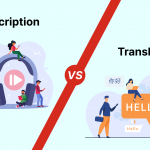
MANAGING PROJECT PARAMETERS
The parameters of a transcription project usually focus on three primary factors:
- Accuracy
- Turnaround time
- Competitive pricing
But what about the needs of the end-user of the transcribed material?
You may face the task of negotiating the best quality product for the lowest price, but if the needs of the end-user are not included, your final price may not reflect your bid price.
Professional transcription services may offer verbatim transcription as a standard, for example, but others may not. Having a clear sense of what you need, will help to identify exactly what the final product will cost.
HOW WILL THE MATERIAL BE USED?
For business transcription, the audio and video files of presentations from multiple tracks at a regional or annual conference, for example, may not need to be transcribed verbatim.
With plenty of supporting documentation, including the PowerPoint slides, a summary of each presentation may be sufficient. Especially if there are audio quality problems or the presentation included multiple speakers.
For academic transcription, the density of the presented material may warrant a verbatim transcription so that all key data is captured. The involvement of a transcriptionist with relevant experience would be critical here, since any issues with audio or video files would require further research. At times, they would even have to contact the presenter directly.
For medical transcription involving patient Electronic Health Records (EHR), accuracy is vital, especially if the notes include treatment and prescription instructions. Patient care can never be based on summary documentation, and complex medical terminology demands the use of qualified medical transcription personnel.
BEGIN WITH THE END IN MIND
As Stephen Covey advises, the potential for success in any project is greatly enhanced if you “begin with the end in mind.” Professional transcription services will give as much attention to the end-user as they will to the quality of the materials with which they will be working. The quality of the audio or video files will present limitations in the level of accuracy that can be achieved, but the quality of the speaker or presenter can direct you to other options.
For example, a nervous, ill-prepared, or easily-distracted speaker may wander off-topic, lose his or her place, or pepper the presentation with “umm’s,” “aah’s,” and extended pauses. Requesting a verbatim transcription to capture all of those is probably not needed, and a good transcription vendor would make that recommendation.
In contrast, transcriptions of podcasts that are available for download on the podcast site so that listeners can read along with the audio and make notations would need to be verbatim. The shorter length of these recordings would make this economically feasible.
It is common for the time and budgetary restrictions to drive any vendor contract. However, for professional transcription services, the needs of the end-user or consumer of the material should always factor into the final decision. Working with a vendor that offers verbatim transcription without charging a premium can have a very positive impact on your project budget.







Share your thoughts